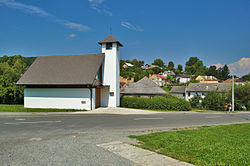Mladeč
Mladeč | |
|---|---|
 Chapel of Saint Florian | |
| Coordinates: 49°42′21″N 17°1′10″E / 49.70583°N 17.01944°E | |
| Country | |
| Region | Olomouc |
| District | Olomouc |
| First mentioned | 1350 |
| Area | |
| • Total | 12.07 km2 (4.66 sq mi) |
| Elevation | 251 m (823 ft) |
| Population | |
| • Total | 720 |
| • Density | 60/km2 (150/sq mi) |
| Time zone | UTC+1 (CET) |
| • Summer (DST) | UTC+2 (CEST) |
| Postal code | 783 21, 784 01 |
| Website | www |
Mladeč (German: Lautsch) is a municipality and village in Olomouc District in the Olomouc Region of the Czech Republic. It has about 700 inhabitants.
Administrative parts
The villages of Nové Zámky and Sobáčov are administrative parts of Mladeč.
Geography
Mladeč is located about 20 kilometres (12 mi) northwest of Olomouc. It extends into three geomorphological regions. The southern part of the municipal territory with the Mladeč and Sobáčov villages lies in the Zábřeh Highlands. The central part lies in the Upper Morava Valley. The northern part with the Nové Zámky village lies in the Hanušovice Highlands.
The Morava River flows through the central area of the municipality. The brook of Mlýnský potok, a tributary of the Morava, also flows through the municipality and is divided here into two branches. There are two fishponds in the municipality: Sobáčovský and Zámecký. Most of the municipality is located in the Litovelské Pomoraví Protected Landscape Area.
History
The first written mention of Mladeč is from 1350. Sobáčov was first mentioned in 1351.
Demographics
Transport
The D35 motorway (part of the European route E442) from Olomouc to the Hradec Králové Region passes through the municipality.
Sights
Mladeč is known for the Mladeč caves. The caves are open to the public.
In Nové Zámky is a Neoclassical castle. It was built in 1813–1820 by a complete reconstruction of an old Baroque hunting lodge, according to the design by Joseph Hardtmuth. Around the castle is a large landscape park.
Archaeology
Mladeč is an Aurignacian archaeological site with directly dated remains of early modern human dating to about 31,000 radiocarbon years. The site contains remains of at least half a dozen individuals, including children. They are the oldest bones that indicate a human settlement or community in Europe. The Mladeč collection also includes Aurignacian tools and art associated with early modern humans. The remains appear to show some Neanderthal-like features.
References
- ^ "Population of Municipalities – 1 January 2023". Czech Statistical Office. 2023-05-23.
- ^ "Historie Mladče" (in Czech). Obec Mladeč. Retrieved 2022-01-11.
- ^ "Historický lexikon obcí České republiky 1869–2011 – Okres Olomouc" (in Czech). Czech Statistical Office. 2015-12-21. pp. 11–12.
- ^ "Population Census 2021: Population by sex". Public Database. Czech Statistical Office. 2021-03-27.
- ^ "Zámek s parkem" (in Czech). National Heritage Institute. Retrieved 2023-08-17.
- ^ Wild, E.; Teschler-Nicola, M; Kutschera, W.; Steier, P.; Trinkaus, E.; Wanek, W. (May 2005). "Direct dating of Early Upper Palaeolithic human remains from Mladec". Nature. 435 (7040): 332–335. Bibcode:2005Natur.435..332W. doi:10.1038/nature03585. ISSN 0028-0836. PMID 15902255.
- ^ Lovgren, Stefan (2005-05-19). "Prehistoric Bones Point to First Modern-Human Settlement in Europe". National Geographic. Archived from the original on 2005-05-22.


